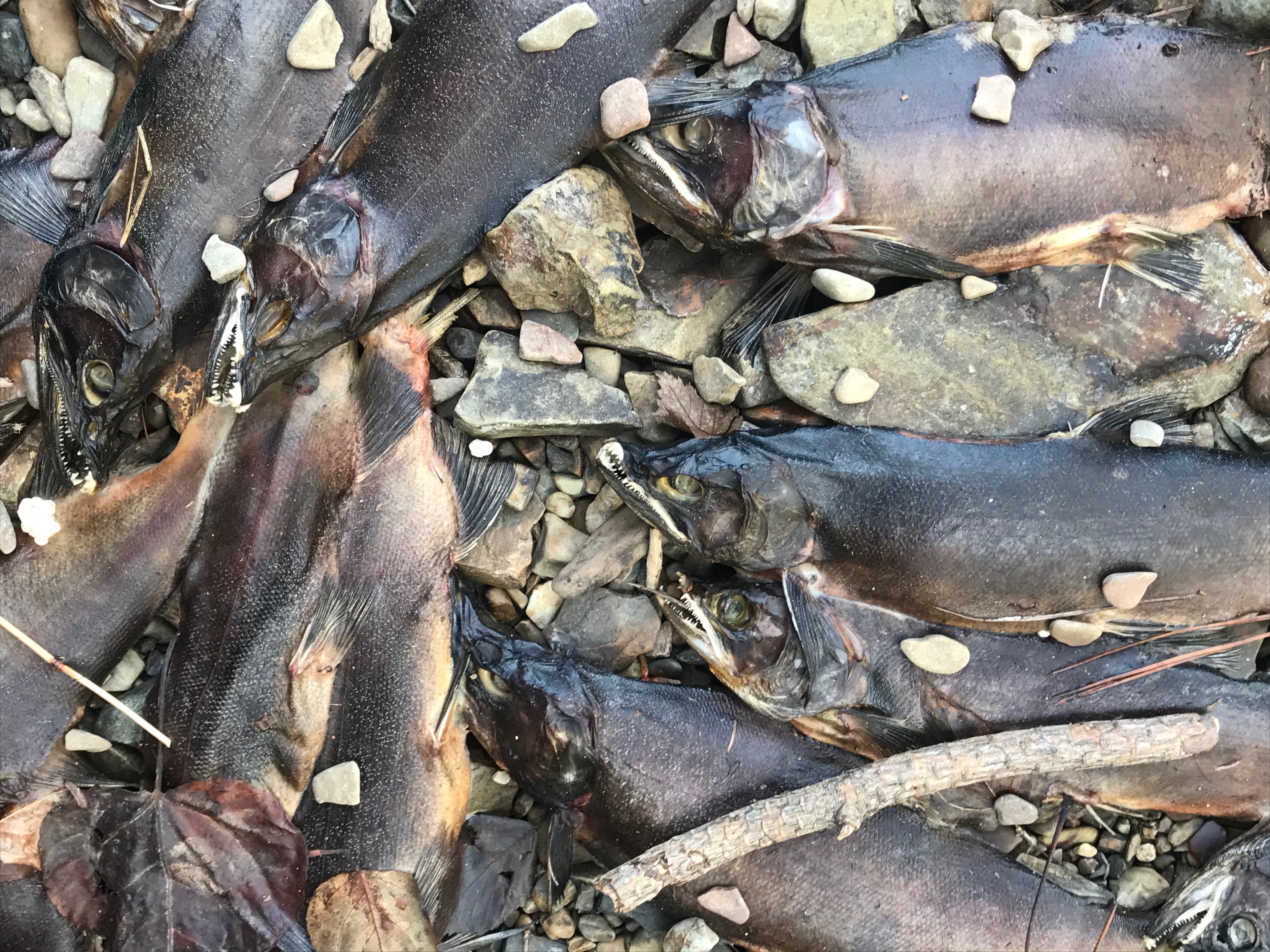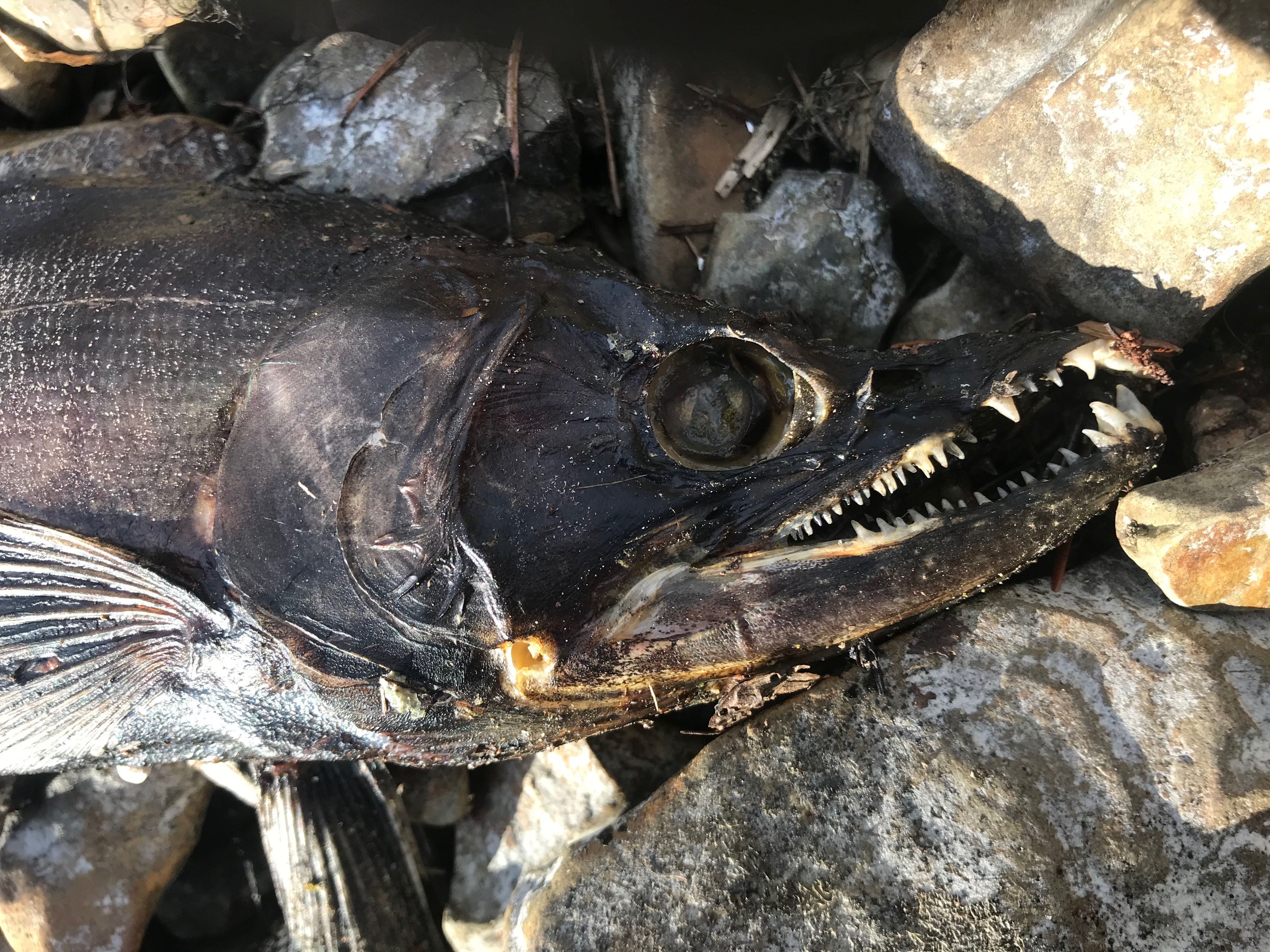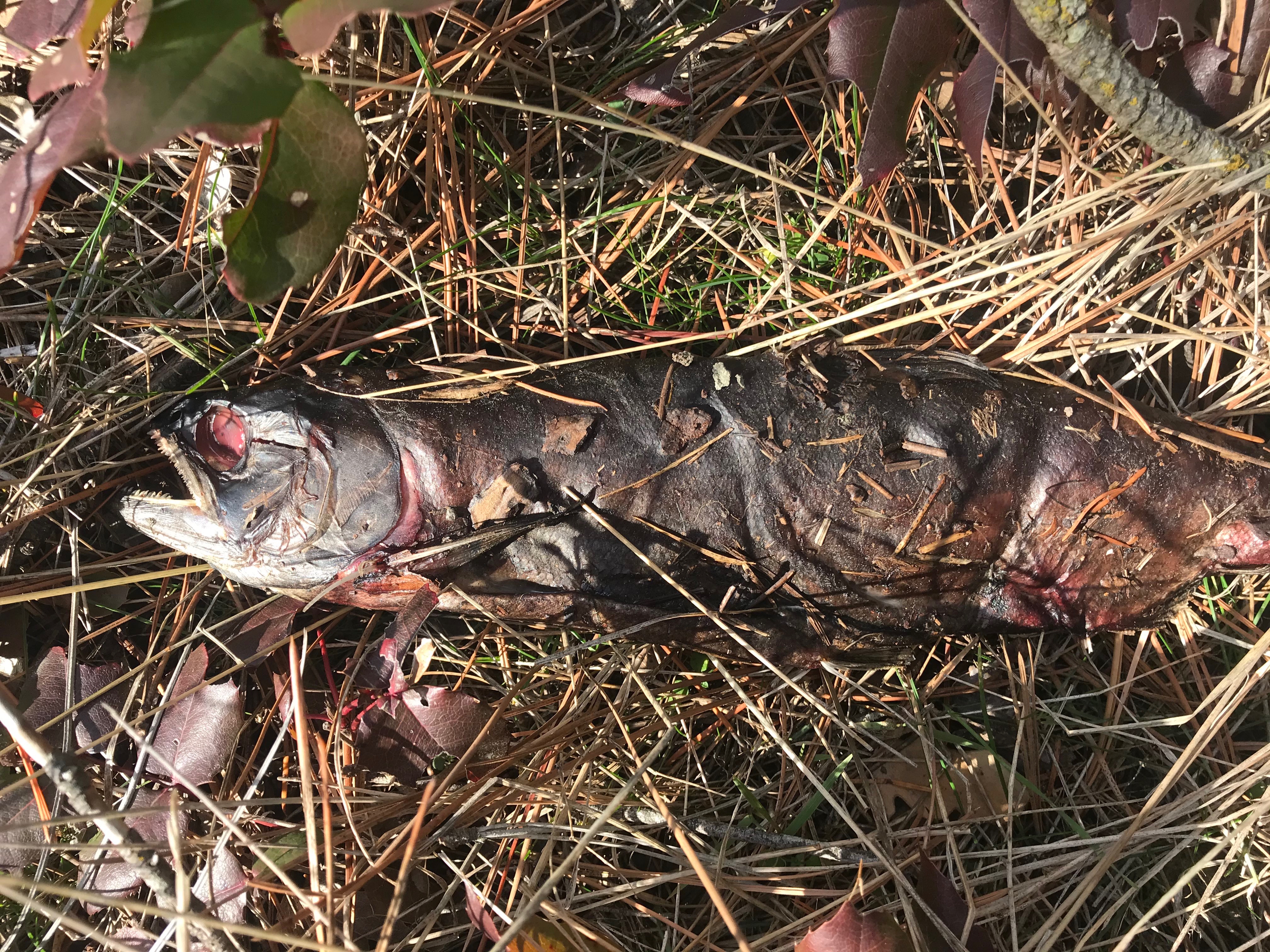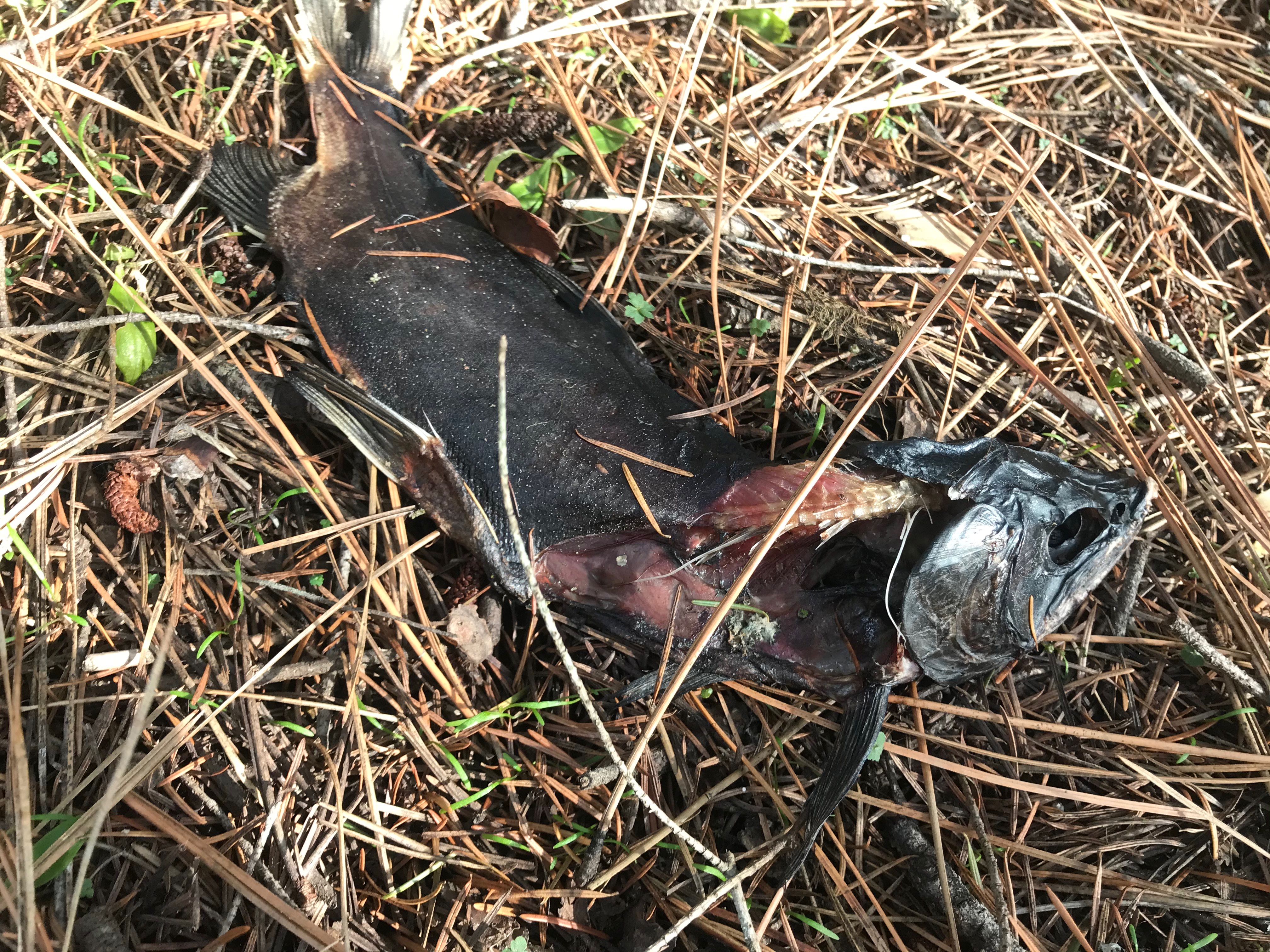
Every fall thousands of kokanee salmon spawn in the rocky shallows of Idaho’s Lake Coeur d’Alene, and every fall hundreds of bald eagles descend to devour them. One frigid, blustery day in early January, Elise and I drove out to catch the tail end of the months-long feast. The eagle flock had been smaller this year than in the recent past, and departed early; by the time we arrived, only four or five still lingered at Higgins Point. The raptors hovered in the stiff gusts like kites and perched miserably in the shuddering ponderosas, so fluffed against the cold they could have passed for birbs.
The kokanee run had long since wrapped up, too, though, unlike the migratory eagles, the salmon would not be departing Lake Coeur d’Alene at journey’s end. Hundreds of spawned-out carcasses lay at the wrack line, decrepit bodies so densely piled that, upon first blush, they were indistinguishable from the cobble. The fish weren’t lying on the beach; they were the beach. Our dog, Kit, tried to roll in the sludge, displaying her species’ unerring instinct for doing the most disgusting possible thing in any given moment.
We dragged Kit away and followed a trail uphill, into the cover of the pines. The salmon seemed to follow. Even hundreds of feet from the lake, their corpses littered the forest floor, staring blindly at us from pecked-out sockets. Needle teeth lined their jaws, which had been transfigured by the spawn into hooked, leering kypes. Some kokanee had chunks missing from their ragged backs; some were only heads. They were most concentrated, I noticed, at the base of the eagles’ perch trees. Quite obviously, they’d been dropped.

Salmon, of course, are nature’s most perfect nutrient packages. At sea, they convert bountiful resources into flesh, then — generously, graciously, as though paying tribute to the river that parented them — convey nitrogen upstream in their failing tissues. They perform the incalculable service of dying, their sacrifice paid forward by the bears and otters and osprey that scatter their bones throughout coastal forests. Trees along salmon streams, research has proven, grow faster than their fishless counterparts, enriched by the gift of skin and guts.
Although I’d seen (and caught) spawning salmon before, I’d never witnessed the “salmon in the trees” concept illustrated as neatly as it was at Lake Coeur d’Alene. The fish lay in the pine needles in various stages of putrefaction,dissolving slowly back into the earth, their meat puddled and melting like ice cream on a summer day.Stuffed bald eagles, so flush with dying fish they couldn’t be bothered to retrieve the meals they dropped, had inadvertently fertilized their own ponderosa grove.

Yet the situation at Higgins Point deviated from the classic story in a couple of respects. First, and most obviously, Lake Coeur d’Alene is, duh, a lake, and thus presumably less nutrient-rich than the ocean. (The kokanee, which is the sockeye salmon’s landlocked form, is much smaller than its species’ marine version precisely for this reason.) To my knowledge, all the studies on salmon’s extraordinary fertilization powers have been conducted along streams that drain to the ocean. Are salmon nitrogenous enough to generate the same benefits even when they’ve spent their lives in the relative poverty of freshwater?
(This is not a rhetorical question — if you know the answer, or at least care to engage in some informed speculation, please comment!)

Even more intriguing is the fact that, a century ago, a visitor to Lake Coeur d’Alene wouldn’t have trod upon even a single dead kokanee. That’s because the fish aren’t native to the lake, having been introduced by the Idaho Department of Fish & Game in the 1930s as cannon fodder for anglers. (The decision was motivated in part by historic mining pollution, which so fouled the Coeur d’Alene River that the watershed’s native cutthroat trout collapsed; apparently it was simpler to release a whole new fish species than clean the place up.) Eagles, in their magical, mysterious way, eventually identified this anthropogenic food source and began gathering in North Idaho en mass. By 1974, they were so entrenched that the Bureau of Land Management began annual counts, which have continued to this day. Together, a non-native fish and North America’s most iconic avian predator had conspired to birth a novel ecosystem.

As we drove home — the wind whipping up chop on the lake behind us, the dog radiating a faint whiff of seafood market from the backseat — I mulled the questions raised by this fascinating ecological dynamic. How does fertilization from landlocked salmon compare to marine fish? Could a biologist with a spotting scope track the nitrogen contributions of individual eagles, as though they’re point sources? Can you detect the date of kokanee introduction in tree rings? This place is a gold mine for enterprising masters students, I’m convinced — why risk grizzly bear attack and mosquito exsanguination in the Alaskan bush when you could study the same phenomenon in the resort town where Kim and Kanye spend their summers?
It’s a reminder, too, of how poorly we understand the world we’ve shaped; the lasting biochemical and ecological consequences of our forebears’ decisions; and the ecosystem engineers around us, always and everywhere, converting flesh to soil to wood and back again, cycling through time and space in the scales of a fish, the feathers of an eagle, the ochre jigsaw bark of a ponderosa pine.
I’ve been fascinated by how Nature can adapt and reinvent itself when humans alter the land in some way. When a wind storm toppled a huge eucalyptus tree behind my apartment building in Santa Cruz, CA, a crew of tree cutters removed the remaining trees to protect the surrounding buildings. I was heart-broken at the carnage. Gone was the tiny urban paradise where a song sparrows sang its heart out to me and a squirrel scolded me daily while hanging from a branch of eucalyptus. The stumps (most about two-three meters across) glared in the sunlight. My Shangri La flipped from damp jungle to searing heat. Soon, though, eucalyptus suckers emerged, covering the tabletop stumps. Wildflowers sprang up like an underground rebellion freed from oppression. Raccoons, squirrels, and even my favorite little song sparrow, returned and flourished in the radiate light. Human impact, even when trying to repair old scars left from industry or agriculture or protect itself from impending disaster, changes the environment for a time; but Nature soon takes control again and incorporates those changes into a new and thriving world. Humans often think they need to repair even these alterations … get the land back to pre-human condition. Why? Nature’s got this.
My obsessed (since a kid) with salmon nature of response to this situation (salmon run introduced by man’s hand) would ask a couple of more fundamental questions as well as make a fundamental observation. First, observation, kokanee or landlocked sockeye salmon provide a path for the copepod derived nutrients, upon which sockeye salmon depend, to be deposited into the forest environments; it is the carbon found where ever this nutrient cycle is present, mostly along the coastal waterways where sockeye salmon runs which depend upon lakes, (not rivers), where algae can grow and provides the food chain base for the copepods and then the sockeye to flourish.
Kokanee replaced the trout (according to the story here) and trout rely on completely different food resources to sustain their ‘run existence’. I think it would be safe to assume they didn’t reach the numbers which the kokanee apparently do. I am sure there is contribution to overall lake enrichment from these salmon as they decay but there must be other sources of nutrients to sustain the algae, plankton, etc.. Has there been any return of the trout that can or could be associated with the presence of the kokanee (as habitat enrichment) over time? How are they doing? From what I understand the Bull trout (a Char), which probably compete with cutthroat trout, are not doing well. And this may or may not have any relationship to the kokanee.
Another bit of information that might need clarification, but I believe kokanee runs typically are NOT self sustaining. Assuming I am correct and these landlocked salmons are not self sustaining where do the brood stock and the resultant hatchery product (fry) come from? Probably from those same or similar stocks which Mr Goldfarb observed. And this leads me to the question I believe more important: how much and where does the money come from that is being used by the state of Idaho to run the hatchery program(s)?